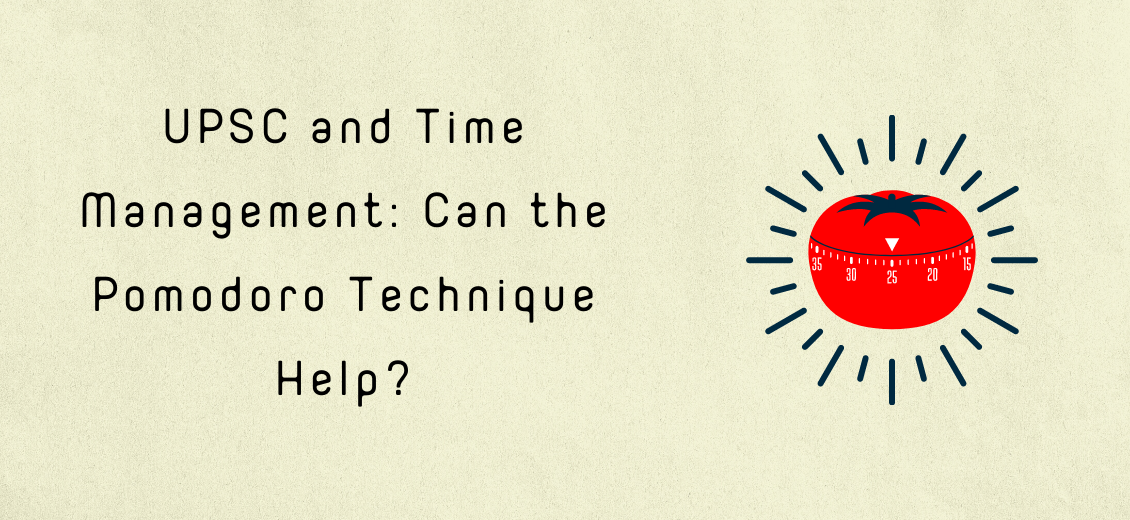UPSC and Time Management: Can the Pomodoro Technique Help?
Blogs Home
- 24 Nov 2021

Are you preparing for UPSC CSE and need help with time management? We all are aware that it can be extremely hard for a UPSC aspirant to cover the myriad topics and ensure they have revised the entire syllabus well in advance. Besides this, taking time out for recreation and other important things is essential to break the monotony of having to read all the study material. While an aspirant must give equal weightage to all the activities, one should also keep track of time and ensure everything is being done as per the plan.
An increase in productivity is the key to success since not everyone can study for 16-18 hours a day. But what if one makes a to-do list and is unable to tick all the tasks off? Despite having a plan, why do they fail? Well, doing the same thing for hours and hours together is counter-productive. So, here we present to you Pomodoro Technique, which can help!
So, What is the Pomodoro Technique?
The Pomodoro technique is a time management tool that helps one focus on work, without any distractions, while also taking frequent breaks. The technique was invented by an Italian author and entrepreneur Francesco Cirillo. This technique was named pomodoro after its inventor used a tomato-shaped timer while working when he was in college (Pomodoro is the Italian word for Tomato).
Pomodoro technique essentially makes things simpler by cutting down work into smaller parts of ideally 25 minutes each (which are called pomodoros). There are breaks after every part of work has been accomplished. It enables one to work faster, with complete attention. While one works hard for the 25 minutes, one has breaks that act as boosters and keep them productive.
How do I Incorporate the Pomodoro Technique into My Routine?
This is how the technique is to be followed:
- Decide upon what you would like to work on.
- Set the timer to 25 minutes (you can either use a Pomodoro timer or a timer app on your phone).
- Work on the task decided upon and stop as soon as the timer rings.
- Take a break of 5 minutes and repeat.
- Take a long break of 15-20 minutes after every 4 pomodoros (ideally after every 2 hours).
Incorporating the technique in one’s life is not hard. It is very much feasible since it provides room for a lot of breaks, while also helping one accomplish their tasks. While one gets ample amount of time to stretch a bit or get something to drink, they also get a lot of time to accomplish their tasks, while not being burdened by work. Tracking one’s progress while working can help one understand how productive each pomodoro has been and therefore manage work better. All that one needs is a pomodoro timer app and they are good to go!
Setting a Pomodoro to 25 minutes is not mandatory and one can go for longer durations (say, 45 minutes) or shorter durations (like 15 minutes) or even random numbers like 34 minutes. Also, in case one has to attend meetings, it can be hard to manage the day since meetings can go on for a couple of hours and it is okay to not use the technique in such instances.
Also, there are many apps and websites that one can use in place of an actual pomodoro timer. One can also add timer apps to the taskbar of their PC. But do remember that the focus is on work and not on the type of timer that one uses. It is also to be noted that one can continue their work even if the timer goes off, and take a break only after the task has been accomplished.
How to Deal With Any Disturbances During a Pomodoro?
It is important to understand that a pomodoro cannot be divided, i.e., one cannot take a break until the timer rings. If one is disturbed by a coworker or if an emergency turns up, they will either have to end the timer or keep working until the pomodoro ends. In case of a distraction, let the distractor know that you are in the middle of your work and ask if you can get back to them after a while. Decide upon when it would be feasible for both of you to catch up again. Once the pomodoro ends and you are free to talk to them, let them know. In case of an emergency, save your work and start a new pomodoro after getting back to work.
Why are 25 Pomodoro Minutes the Ideal Time?
- The essence of a Pomodoro timer is to push procrastinators to get to work and a 25-minute time frame is ideal for them since they might not even want to begin working in the very first place.
- 25 minutes is not too long that one begins to procrastinate, while it is also not too short that one cannot accomplish some tasks at hand.
- When one knows they are to complete the task by the time the timer rings, they tend to work faster.
- 25 minutes help plan the day better since 2 pomodoros can fit inside an hour without much effort.
- Even if several pomodoros are essential for one to finish a particular task, they are motivated to start working since they know they can take breaks after only 25 minutes and as such work at their own pace.
Why is the Pomodoro Technique Important?
The Pomodoro technique is important since it can help improve one’s concentration as well as attention spans. It has not been curated for a particular type of person and can be used by anyone who wants to accomplish any task. While it might feel like a lot of time is being lost on breaks, it is important to remember how monotony can prove detrimental while carrying out focused work.
This technique helps one keep themselves away from surfing the internet or checking emails while working and increases their focus. It can be surprising for one to see how much they can achieve in a very little amount of time. One need not necessarily use the technique every single time they sit to work - it can just be used when they wish to be the most productive.
Conclusion
While the Pomodoro technique has proven to be useful for many, it is also to be understood that it need not necessarily suit everyone. But do ensure you take frequent breaks and do not stress yourself by working for hours and hours together. In the end, it is more about focusing on things that you need to do, while also doing things you would like to do. Finally, there is room for remixing the technique with other productivity hacks to optimally put to use one’s potential.

Uma Sathwika Manda
Blogs Home



